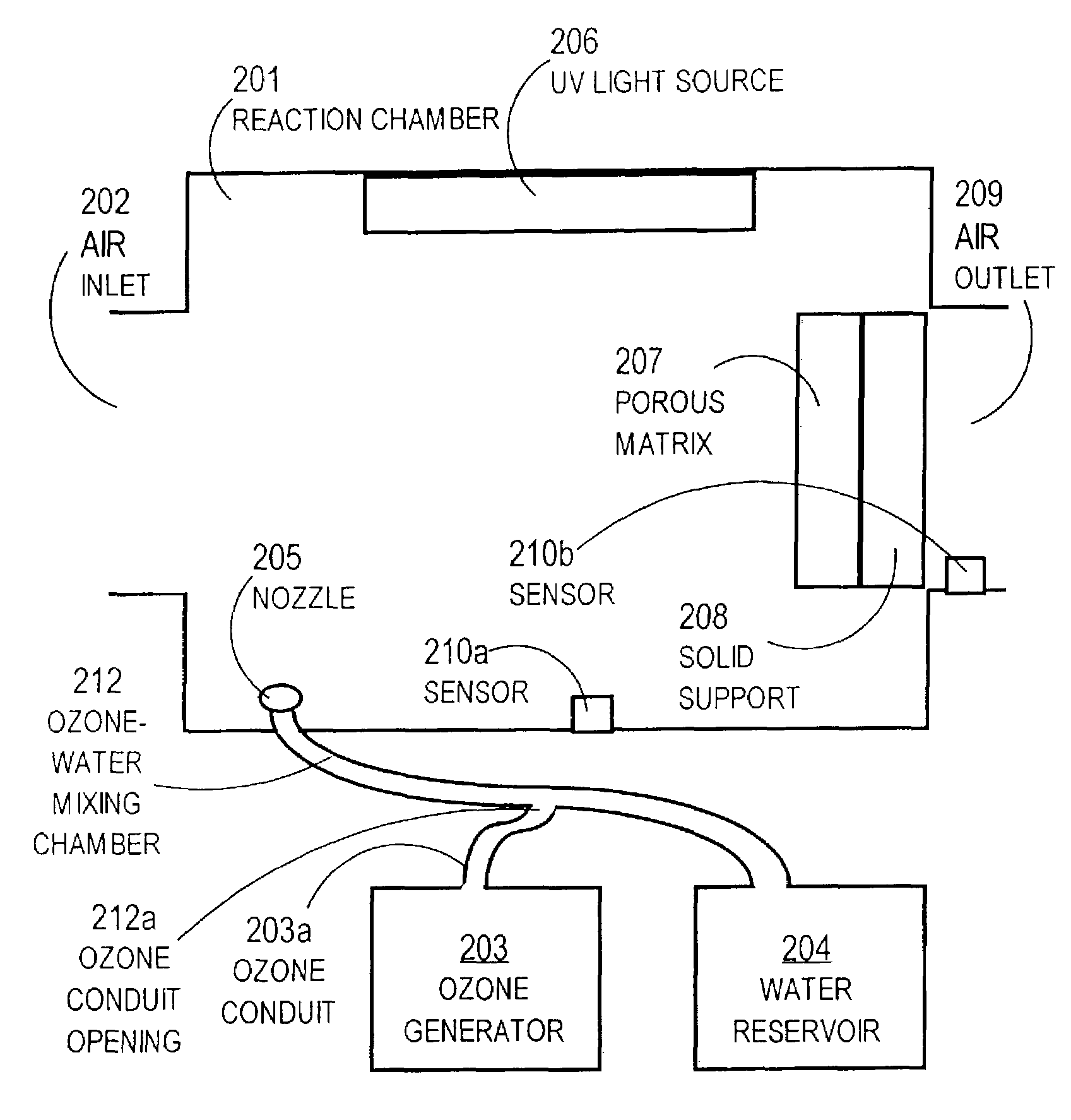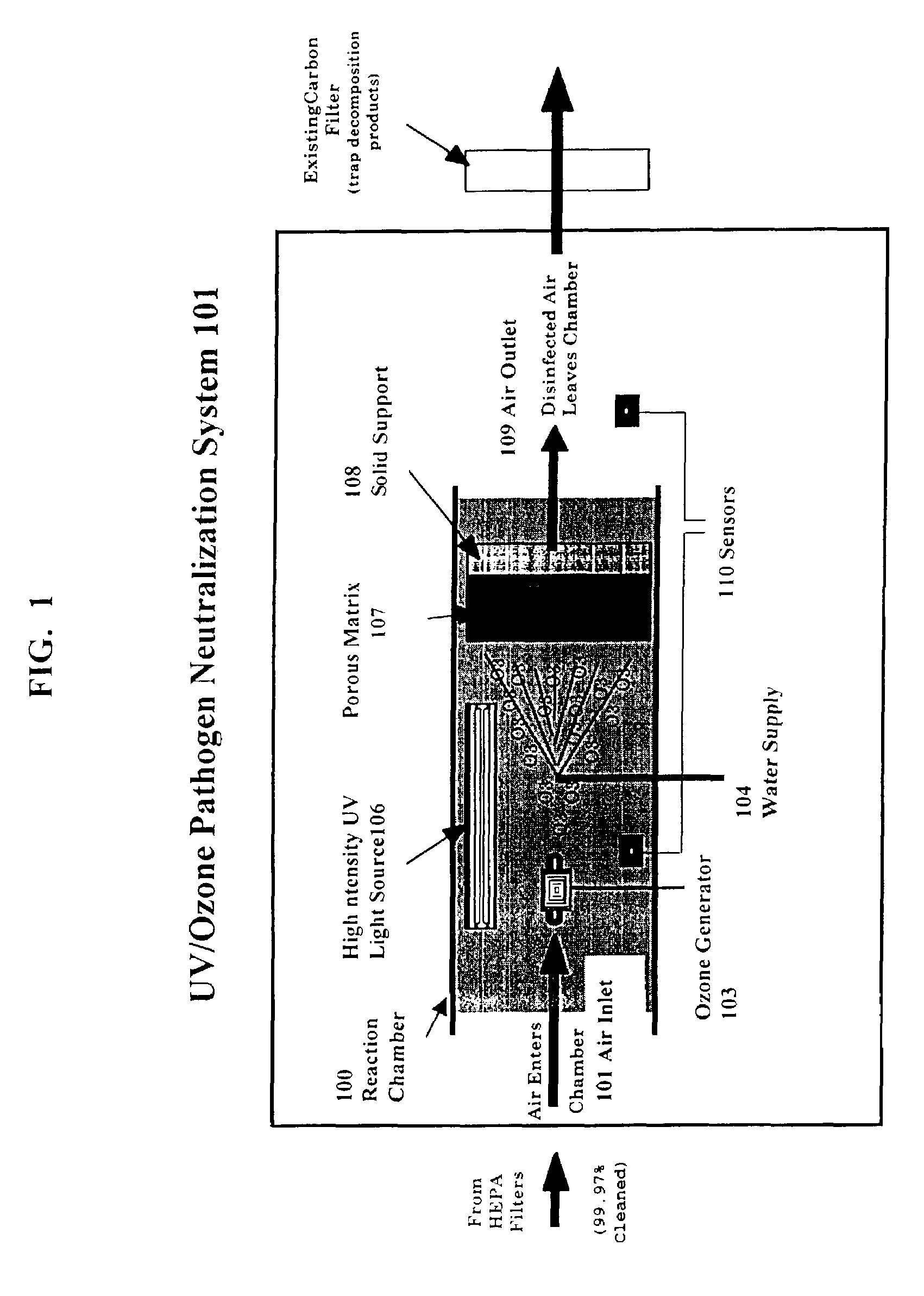Method and apparatus for air treatment
- Summary
- Abstract
- Description
- Claims
- Application Information
AI Technical Summary
Benefits of technology
Problems solved by technology
Method used
Image
Examples
example 1
A. The Neutralization System
[0089]The neutralization system used in this experiment is shown in FIG. 2, with the exception that the solid support 208 with ozone removal catalysts was not included, and the system also included a fan to help pull air through the system. The fan was turned on in all experiments. A CD-5 GENESIS™ corona discharge ozone generator made by Del Industries, Inc. with maximum output of 5 g / hr was disposed outside the reaction chamber as shown in FIG. 2. Downstream from the ozone generator 203 and ozone conduit 203a, is a water reservoir 204 that releases a stream of water into the water / ozone conduit 212. As the water stream flows through the water / ozone conduit, it creates a vacuum that helps to pull the ozone gas exiting the ozone generator 203 through ozone conduit 203a into the water / ozone conduit 212 at conduit opening 212a. The UV light source (206 consisted of two BioAire —UV Lights Model BUV 24DE Double Ended Fixtures. The brand of light is not critica...
example 2
The UV / Ozone Pathogen Neutralization System Completely Eliminated Large Amounts of Airborne Vegetative Cells of Erwinia
[0095]The neutralization system was set up as described in Example 1. Various experiments were designed to assess the ability of the system to neutralize airborne Erwinia herbicola bacteria. In all experiments, air was passed through the system for thirty minutes while the system fan was continuously on. In certain of these experiments, large amounts of airborne vegetative cells of Erwinia herbicola bacteria (about 5.3×109 CFU / ml) were introduced into the air entering the reaction chamber through the air inlet as is described in Example 1B using a MICRO MIST™ nebulizer. Incoming air (with or without Erwinia herbicola) was sampled continuously just before entering the neutralization system via the air inlet, and outgoing air was sampled just as it leaves the system, as described in Example 1.
[0096]In FIGS. 5A-H, System inlet and System outlet plates (dishes) were con...
example 3
[0101]Large amounts of airborne vegetative cells of Bacillus globigii (13G) spores (a simulant for the anthrax spores), were introduced into the chamber air inlet of a neutralization system as described in Example 1 using a MICRO MIST™ nebulizer under several different sets of conditions. Bacillus globigii spores are known to be particularly difficult to neutralize. In all experiments, air was passed through the system for thirty minutes while the system fan was continuously on.
Control-No Spores, All Systems Off-Fan Only
[0102]As a control, room air was drawn through an inactive neutralization system before any spores were intentionally introduced. The water was off, the ozone generator was off, and the UV light was off. Both the System inlet plates exposed to incoming air and System outlet plates exposed to outgoing air that had passed through the inactivated neutralization system, showed no growth of bacteria after the thirty minutes that air was passed through the reaction chamber...
PUM
 Login to View More
Login to View More Abstract
Description
Claims
Application Information
 Login to View More
Login to View More - R&D
- Intellectual Property
- Life Sciences
- Materials
- Tech Scout
- Unparalleled Data Quality
- Higher Quality Content
- 60% Fewer Hallucinations
Browse by: Latest US Patents, China's latest patents, Technical Efficacy Thesaurus, Application Domain, Technology Topic, Popular Technical Reports.
© 2025 PatSnap. All rights reserved.Legal|Privacy policy|Modern Slavery Act Transparency Statement|Sitemap|About US| Contact US: help@patsnap.com



